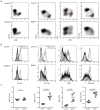Batf3 selectively determines acquisition of CD8+ dendritic cell phenotype and function
- PMID: 27897162
- PMCID: PMC5309136
- DOI: 10.1038/icb.2016.83
Batf3 selectively determines acquisition of CD8+ dendritic cell phenotype and function
Abstract
Batf3 is a transcription factor that impacts the development of CD103+ tissue-resident dendritic cells (DCs). However, whether Batf3 is absolutely required for the development of CD8+ DCs remains controversial. Id2 is required for CD8+ DC development. Here we show that bone marrow chimeric mice with a deletion of Id2 in the CD11c compartment lose the ability to reject a skin graft expressing a non-self protein antigen or mount a delayed hypersensitivity response. In contrast, Batf3-/- mice remained competent for skin graft rejection and delayed hypersensitivity, and retained a CD8+ DC population with markers characteristic of the CD11b+ DC lineage, including CD11b, CD4 and CD172α, as well as the key regulator transcription factor IRF4, but lacked IRF8 expression. CD8+ DCs in Batf3-/- mice took up and cleaved protein antigen and larger particles but were unable to phagocytose dying cells, a characteristic feature to the CD8+ DC lineage. These data clarify a requirement for CD8+ lineage DCs to induce effectors of neo-antigen-driven skin graft rejection, and improve our understanding of DC subtype commitment by demonstrating that in the absence of Batf3 CD8+ DCs can change their fate and become CD11b+ DCs.
Conflict of interest statement
The authors declare no competing financial interests.
Figures




Similar articles
-
CD8α+ DCs can be induced in the absence of transcription factors Id2, Nfil3, and Batf3.Blood. 2013 Feb 28;121(9):1574-83. doi: 10.1182/blood-2012-07-445650. Epub 2013 Jan 7. Blood. 2013. PMID: 23297132
-
Batf3-dependent CD11b(low/-) peripheral dendritic cells are GM-CSF-independent and are not required for Th cell priming after subcutaneous immunization.PLoS One. 2011;6(10):e25660. doi: 10.1371/journal.pone.0025660. Epub 2011 Oct 17. PLoS One. 2011. PMID: 22065991 Free PMC article.
-
Peripheral CD103+ dendritic cells form a unified subset developmentally related to CD8alpha+ conventional dendritic cells.J Exp Med. 2010 Apr 12;207(4):823-36. doi: 10.1084/jem.20091627. Epub 2010 Mar 29. J Exp Med. 2010. PMID: 20351058 Free PMC article.
-
Concise review: The heterogenous roles of BATF3 in cancer oncogenesis and dendritic cells and T cells differentiation and function considering the importance of BATF3-dependent dendritic cells.Immunogenetics. 2024 Apr;76(2):75-91. doi: 10.1007/s00251-024-01335-x. Epub 2024 Feb 15. Immunogenetics. 2024. PMID: 38358555 Review.
-
Terminal differentiation of dendritic cells.Adv Immunol. 2013;120:185-210. doi: 10.1016/B978-0-12-417028-5.00007-7. Adv Immunol. 2013. PMID: 24070385 Review.
Cited by
-
Albumin and interferon-β fusion protein serves as an effective vaccine adjuvant to enhance antigen-specific CD8+ T cell-mediated antitumor immunity.J Immunother Cancer. 2022 Apr;10(4):e004342. doi: 10.1136/jitc-2021-004342. J Immunother Cancer. 2022. PMID: 35459734 Free PMC article.
-
Characterization of Gene Expression Signatures for the Identification of Cellular Heterogeneity in the Developing Mammary Gland.J Mammary Gland Biol Neoplasia. 2021 Mar;26(1):43-66. doi: 10.1007/s10911-021-09486-3. Epub 2021 May 14. J Mammary Gland Biol Neoplasia. 2021. PMID: 33988830 Free PMC article.
-
The COX2 Effector Microsomal PGE2 Synthase 1 is a Regulator of Immunosuppression in Cutaneous Melanoma.Clin Cancer Res. 2019 Mar 1;25(5):1650-1663. doi: 10.1158/1078-0432.CCR-18-1163. Epub 2018 Dec 11. Clin Cancer Res. 2019. PMID: 30538110 Free PMC article.
-
Absence of Batf3 reveals a new dimension of cell state heterogeneity within conventional dendritic cells.iScience. 2021 Apr 15;24(5):102402. doi: 10.1016/j.isci.2021.102402. eCollection 2021 May 21. iScience. 2021. PMID: 33997687 Free PMC article.
-
Differential Response of Human Dendritic Cells upon Stimulation with Encapsulated or Non-Encapsulated Isogenic Strains of Porphyromonas gingivalis.Int J Mol Sci. 2024 Apr 20;25(8):4510. doi: 10.3390/ijms25084510. Int J Mol Sci. 2024. PMID: 38674095 Free PMC article.
References
-
- Bedoui S, Whitney PG, Waithman J, Eidsmo L, Wakim L, Caminschi I, et al. Cross-presentation of viral and self antigens by skin-derived CD103+ dendritic cells. Nat Immunol. 2009;10(5):488–95. - PubMed
-
- Seillet C, Belz GT. Terminal differentiation of dendritic cells. Adv Immunol. 2013;120:185–210. - PubMed
Publication types
MeSH terms
Substances
Grants and funding
LinkOut - more resources
Full Text Sources
Other Literature Sources
Research Materials

